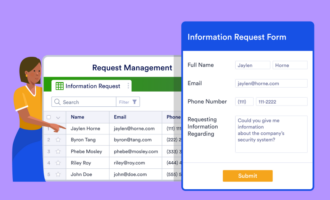Rote and repetitive tasks may be easy to complete, but they eat up time and drain mental energy. That’s why industry-leading online retailers automate recurring tasks, like those required to process and fulfill orders. Streamlining basic e-commerce business functions stabilizes operations, protects staff from burnout, and positions your company for more growth.
An introduction to e-commerce
The e-commerce market is bigger than ever. Oberlo predicts that more than 2.7 billion people will be shopping online by the end of 2025 — roughly 30 percent of the global population. This growth has translated into consumers spending $1.03 trillion with online merchants in 2022, up 7.7 percent year over year. This is great news for e-commerce retailers, who can expect their revenue to continue growing.
Growth in e-commerce doesn’t just present a business opportunity. As online consumers become more discerning, companies have to get creative with the ways they keep up with demand. That means automating their e-commerce workflows is essential.
The basics of an e-commerce workflow
An e-commerce workflow is a set of steps that an order goes through — from placement to delivery, and sometimes beyond. While your e-commerce workflows will be unique to your business’s processes, some common steps include the following: order entry, payment processing, order confirmation, fulfillment, inventory management, shipping updates, and delivery confirmation.
E-commerce workflow automation
Workflow automation helps your e-commerce business get busywork done faster so employees can spend more energy on projects that truly matter. Automating processes also improves the accuracy of data and increases overall efficiency.
E-commerce workflow automation is a way for small online businesses to streamline recurring and repetitive processes by delegating them to apps and other software tools. For instance, automation tools like Jotform Workflows drastically reduce the amount of time it takes to confirm an order with the help of order approval process templates.
Automation can be as simple as a system that automatically generates notifications about project updates instead of having someone type out a response. One of the most common automations in an e-commerce workflow is automatically confirming a customer’s order when it’s received.
In the past, when a customer submitted their payment, an employee had to manually generate an order number and email the customer to let them know that their order was in process. This might have taken only a few minutes, but when companies process dozens or hundreds of orders daily, manual responses take hours. Today, giving employees this time back allows them to get higher-level work done — which is good for your bottom line, your team’s morale, and your customers.
A typical e-commerce workflow process
Here are the most common steps of an e-commerce workflow and why they’re important.
Product sourcing
In this step, e-commerce owners need to find the right vendors, suppliers, and manufacturers to offer their desired products.
Listing
Selling your products online starts with getting them in front of your customers – whether on a third-party site or your own online store. The listing process is critical — after all, where you list your products and how you list them determines how quickly they’ll sell.
Order processing
When customers place orders, they set off a chain of processes that are the backbone of your e-commerce business. On your end, you must approve, confirm, and then fulfill orders quickly to keep customers happy and sales moving. (While fulfillment is a process of its own, it’s also considered part of getting customer orders processed and delivered on time.)
Fulfillment
The fulfillment portion of order processing involves several departments. Moving orders from your back office to the warehouse and then getting those orders shipped to customers on time requires a number of tasks that all have the potential to introduce errors if not properly managed.
Post-sale management
Once you deliver your product to a customer, your relationship with them isn’t over. Post-sale management includes the nurturing of customer relationships, which is vital to building brand loyalty and repeat business.
Inventory management
Keeping inventory up to date helps you maintain customer satisfaction, streamline sales, and ensure all your teams are on the same page. If your customers order products that aren’t available, they could become frustrated, leading to negative reviews and the need for damage control.
Analytics and reporting
Your business’s success depends on how well you understand your metrics so you can better adapt to market changes and demands. Collecting key performance metrics offers insight into how well your business is doing, where you can improve, and which customers are providing the most value.
Common obstacles to efficient e-commerce workflows
Over time, e-commerce workflow processes can become outdated, overly complex, and unreliable. Here are some common obstacles to efficiency that you should address to build efficiency.
Manual data entry and errors
If your workflow requires employees to enter data manually, you’re not only adding an unnecessary burden to their workflow, but also risking human error. Accurate data drives every part of your business, so mistakes can create serious backlogs.
Lack of integration between systems and platforms
If your systems aren’t working in sync, you’re leaving money on the table. Siloing tasks can mean your team has to put more effort into getting things done and can result in inaccurate data, roadblocks, and a lack of visibility into your workflow as a whole.
Poor order fulfillment and shipping processes
Customers want to receive their orders quickly. Manual processes increase the burden on your team to get orders out and confirmed, and they risk customer backlash over long wait times.
Inadequate inventory management
Improper inventory tracking leads to under-ordering, which can upset customers when the item they want is out of stock. Inaccurate inventory numbers also force your team to work harder to recover customers and issue refunds, potentially risking negative reviews.
Slow or unreliable payment processing
The last thing you want is to make it hard for your customers to pay you. Likewise, you don’t want obstacles keeping you from paying vendors. Slow and unreliable payment processing hurts your bottom line through inaccurate information, bottlenecks, and lost customers.
Poor customer communication and follow-up
Customer service is the front line of your business. If your team can’t communicate effectively with customers due to a lack of resources or time, the result will be significant customer churn, a serious hit to your bottom line, and less confidence in your brand.
Inadequate product information and data management
Product listings should give your customer all the information they need to feel confident about buying your product. If you provide inadequate or inaccurate data, they won’t make the purchase. Data mismanagement also confuses employees who are trying to help your customers.
Overly complex returns and refund processes
When your customers experience issues, you don’t want to frustrate them even further by making it difficult for them to complete returns or refunds. Streamlining these processes will help build confidence in your customer service and retain customers.
Inefficient product-sourcing and vendor-management processes
Without the right processes in place, you risk exposing your business to potential supply chain issues. A mismanaged supply chain results in a lack of products on-site, poor relationships with vendors, and decreased sales.
Slow or complicated processes are vulnerable to errors, which can stress out your employees and cost you revenue. But workflow automation addresses issues and strengthens your processes at every stage.
Steps for building an automated e-commerce workflow
Before you try to automate your entire business, it’s important to realize it takes time and effort to do automation right. If you’re new to automation, you can start with one process to get a feel for it and see how much easier your work becomes.
Here are the steps to apply e-commerce workflow automation.
Visualize the process
Before you start building an automated workflow, create a flowchart or other visual of what the process will look like. Think of this as a map of the actions you need to take and when you need to take them.
Determine needs
Before you finalize this flowchart, check with the employees involved in the workflow to make sure it includes everything they’ll need. For example, if you’re creating an automated workflow for refunds, loop in operations and accounting, the two departments that will use the workflow the most. Ask for their input about the functionality they want.
Choose an automation solution
There’s no shortage of e-commerce workflow platforms. Jotform is a flexible option, as it integrates directly with some of the most popular productivity solutions, including Asana, Trello, and Airtable. Jotform also integrates with Zapier for even more options, including Shopify.
Test the process
Before you fully rely on your newly automated workflow, make sure it works perfectly. It’s easy to leave out important steps without realizing it until you actually run a workflow a few times. Let the employees who’ll use the workflow the most try it. They’ll spot issues faster than anyone else.
Advantages of automating e-commerce workflows
Automating e-commerce workflows will not only help your business run smoothly, but also help it to grow and improve over time. Here are some of the benefits to automation.
Improved accuracy
E-commerce businesses must adapt to meet demand, which means constantly cutting down wait times, order error rates, and fulfillment constraints. Workflow automation removes the many of the inefficiencies that hamper improvement in these areas.
Enhanced scalability
If your business relies on manual processes, your ability to scale is limited by the size of your workforce and how quickly they can complete tasks. Through automation, you enhance your growth potential beyond your workforce.
Reduced costs
By freeing up employees to focus on complex tasks, you’ll lower your labor costs and increase the value they provide to your organization.
Improved customer experience
Customers want their orders as soon as possible, and automating e-commerce workflows makes this possible. Automation shrinks wait times and errors, minimizing customer complaints and creating a better shopping experience that increases brand loyalty.
Better data management
Choosing the right workflow automation tools gives your team centralized access to vital e-commerce data. This data transparency empowers your employees, decreases the number of errors, and optimizes each department.
Increased visibility
Workflow automations allow you to see every stage of an order as it’s happening. Having this insight helps prevent errors and ensures every stage of your process is working correctly. And it allows your workers to see which processes they can improve.
Enhanced competitiveness
To stay competitive in the marketplace, your business needs to meet the customer expectations that key players like Amazon, Walmart, and eBay have set. Automation allows you to meet those expectations and gives you a leg up on competitors that don’t automate their operations.
Pro Tip
Check out Jotform founder Aytekin Tank’s new book, Automate Your Busywork, to learn how to use no-code automation to offload repetitive tasks and boost your organization’s efficiency.
Areas to automate in your e-commerce workflow
A wide array of tools can streamline almost every aspect of your e-commerce workflows. Here are some examples of areas that can benefit from automation.
Purchase orders
When your company needs to restock supplies, online order request forms collect all the necessary information. When they’re part of a purchase order approval workflow, the appropriate managers will get a notification when someone completes a form, and they can approve or deny the request with a click.
Refunds
Returns are inevitable for every kind of merchant. Refund approval templates can formalize the process for reviewing each request and authorizing repayment.
Vendor/supplier relations
You can improve new vendor onboarding by automating data collection with online vendor application forms. Vendor approval templates send these forms to the right people through the proper channels.
Tools for automating e-commerce workflows
The tools you need for e-commerce workflow automation will depend on which workflows you plan to automate. Certain tools handle specific workflows, so be sure to choose one that addresses your needs.
Order management systems
An order management system (OMS) allows you to automatically track an order throughout its journey from you to a customer. An OMS offers insights into order placement, fulfillment, delivery, after-sale service, inventory management, and more.
Shipping software
To keep up with the modern demand for two-day shipping that Amazon created, you need shipping software that generates shipping estimates for customers, creates shipping labels, and automatically updates customers on the shipping status of their order.
Approval software
When a customer orders a product, it’s easy for their order to sit idle while waiting for someone to approve it. Through powerful workflow tools like Jotform Workflows, your e-commerce workflows streamline your order approval process and eliminate bottlenecks for customers, vendors, and suppliers. You can use one of Jotform’s approval flow templates or build your own approval workflows.
Online form builders
Order forms, invoices, surveys, and every type of form in between are an efficient, professional way to communicate with your customers. Online form builder Jotform offers drag-and-drop functionality, thousands of templates, and a suite of features to help you get the most out of your forms. You can also create your own custom online store with Jotform Store Builder.
Better automation with Jotform
Keeping up with the pace of the growing e-commerce market is no easy feat — but automating your workflow processes will help ensure you reach your sales goals. With the right tools, you can optimize every part of your business, simultaneously easing your workload and growing your customer base. Start automating your e-commerce workflow today.





















































































Send Comment: